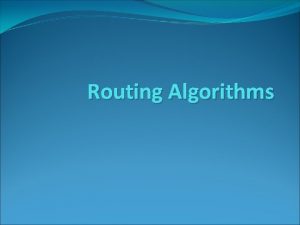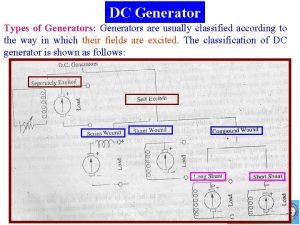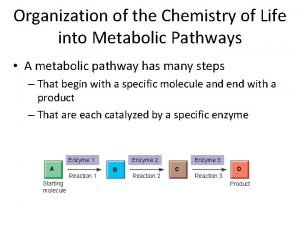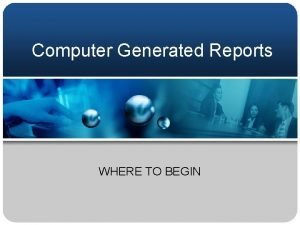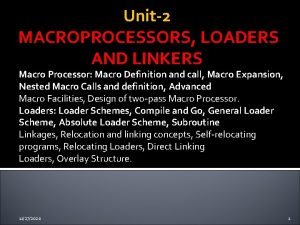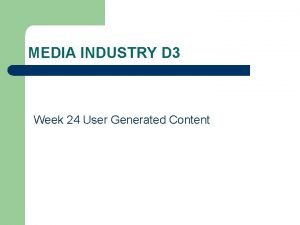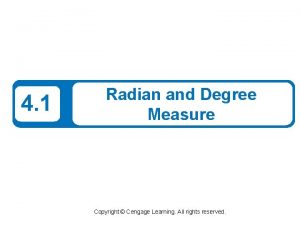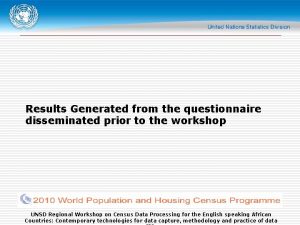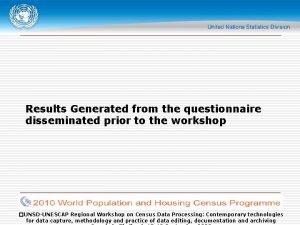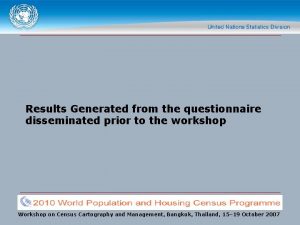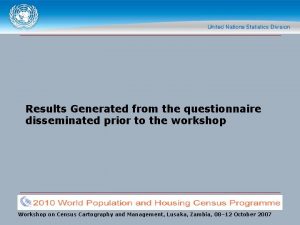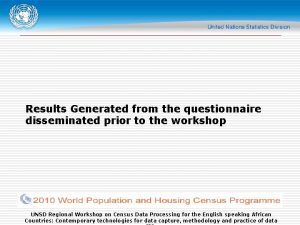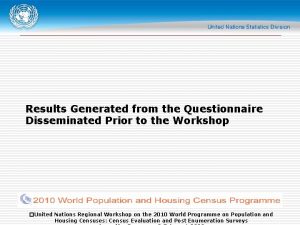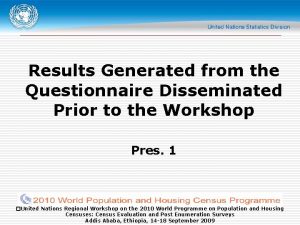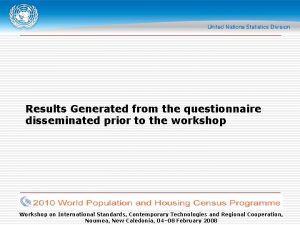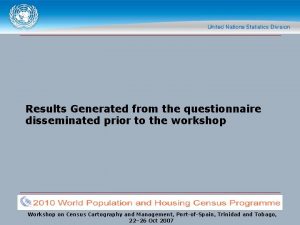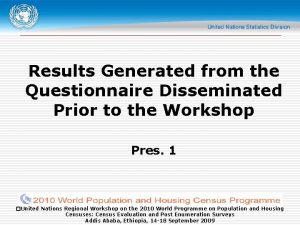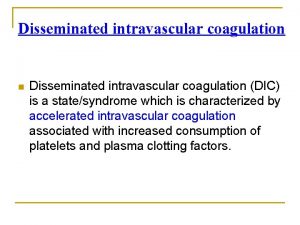Results Generated from the questionnaire disseminated prior to














- Slides: 14

Results Generated from the questionnaire disseminated prior to the workshop �UNSD-UNESCAP Regional Workshop on Census Data Processing: Contemporary technologies for data capture, methodology and practice of data editing, documentation and archiving

The objective of the questionnaire • To better understand data processing activities at the country level • To invite country experiences with the goal of providing a forum for further collaboration on the effective use of techniques and methods in data processing • To support the development and management of the workshop and future activities • To understand what information and technical training is needed on the use of specific daata processing methods �UNSD-UNESCAP Regional Workshop on Census Data Processing: Contemporary technologies for data capture, methodology and practice of data editing, documentation and archiving

Data Capture: Methods for census/survey data capture • Common methods used for census survey data capture were: • manual data entry • OMR • ORC/ICR • Several countries are interested advancing efficiency through the use of PDA’s and Internet �UNSD-UNESCAP Regional Workshop on Census Data Processing: Contemporary technologies for data capture, methodology and practice of data editing, documentation and archiving

Data Capture: Scanners and features used by countries: • Kodak i 610 80 - 320 images/sheets per min. (Philippines) • Kodak 3510 200 dpi (60 - 75 ppm) 300 dpi: (40 -50 ppm (Singapore -2000 round) • Fujitsu M 4099 D ~90 ppm [simplex] to 180 images per minute [duplex], up to 400 dpi (Malaysia) • All dependent on resolution, orientation, feeding, etc. �UNSD-UNESCAP Regional Workshop on Census Data Processing: Contemporary technologies for data capture, methodology and practice of data editing, documentation and archiving

Data Capture: outsourcing of processes • With concern to manual data entry, the data capture process is not always outsourced. • • Methods included the use of a database management system such as Oracle along with CSPro where data entered, edited and coded in-house. With concern to OMR & OCR/ICR the data capture process is often partially or entirely outsourced. �UNSD-UNESCAP Regional Workshop on Census Data Processing: Contemporary technologies for data capture, methodology and practice of data editing, documentation and archiving

Data Capture: Planned data capture method for next census round • Some countries are undecided as of which method to choose • OMR/OCR/ICR is planned for use by many countries will all or part of the process outsourced (e. g. Bangladesh, Indonesia, Sri Lanka) • Mobile Devices/Internet are also proposed for use (e. g. Singapore, Iran- [surveys]) �UNSD-UNESCAP Regional Workshop on Census Data Processing: Contemporary technologies for data capture, methodology and practice of data editing, documentation and archiving

Data Capture: Archiving methods and policies used for storing forms • Many countries use electronic means for the storage of forms. Some countries store forms both electronically and in hardcopy format. • Several countries have laws requiring the storage of forms for a given time. • Issues raised in the storage of hardcopy forms are that they take up space and may be damaged after a given time period. �UNSD-UNESCAP Regional Workshop on Census Data Processing: Contemporary technologies for data capture, methodology and practice of data editing, documentation and archiving

Data Editing: Coding for Major Classifications of Occupations • All offices use coding for major classifications of occupations, industry and education. • • Occupation- most use ISCO with several countries using nationally specific systems also Industry- most use ISIC with several countries using nationally specific systems also Education- Most countries use ISCED with several countries using nationally specific systems also Ethnicity was also mentioned as a major classification in which coding is used. �UNSD-UNESCAP Regional Workshop on Census Data Processing: Contemporary technologies for data capture, methodology and practice of data editing, documentation and archiving

Data Editing: Manual or Automated Coding • Coding is done manually in most cases with some countries using both manual and automated methods. • • When automated, the software is developed in house (e. g. Egypt) or through a commercial produced such as Oracle (Lebanon) or developed by a private contractor and configured further by NSO staff (e. g. Morocco) Most countries have an editing system as a part of the census/survey processing phase • The dominant error detection systems expressed within the questionnaire were • validity check & consistency check • Also mentioned- Across and Within record, macro tabulation �UNSD-UNESCAP Regional Workshop on Census Data Processing: Contemporary technologies for data capture, methodology and practice of data editing, documentation and archiving

Data Editing: • In many cases manual methods for imputation are used with the following software CSPro, IMPS, SPSS, Oracle. • Countries create automated routines using statistical software tools such as SPSS and STATA and batch editing programs attached with the data entry program (CSPro batch editing tool). • Several countries expressed in the questionnaire that alongside software such as CSPro, editing system routines will be developed in-house (e. g Bangladesh, Rep. of Korea, Phillipines) �UNSD-UNESCAP Regional Workshop on Census Data Processing: Contemporary technologies for data capture, methodology and practice of data editing, documentation and archiving

Staff and Training Iran Data capture Data coding Error detection Imputation Part-time 414 729 450 10 Philippines Data capture Data coding Error detection Imputation Full-time 400 + 150 + 50 10 Rep. of Korea Data capture Data coding Error detection Imputation Sri Lanka Data capture Data coding Error detection Imputation Part-time Full-time Ad-hoc 700 13, 000 5 70 20 350 10 150 50 Full-time 75 40 20 20 Nepal Full-time Data capture 10 Data coding 20 Error detection 5 Imputation 2 Part-time 100 5 2 Indonesia Full-time Data capture 132 Data coding 165 Error detection 165 Imputation 99 Ad-hoc 702 1, 053 1, 332 594 �UNSD-UNESCAP Regional Workshop on Census Data Processing: Contemporary technologies for data capture, methodology and practice of data editing, documentation and archiving

Cont… • Training for each step ranges widely across countries • Data Capture ~5 days to 1 month • Data Coding ~5 days to 2 weeks • Error Detection ~5 days to 3 weeks • Imputation ~ 1 Day to 3 weeks Example: Manual Data capture - 1 week Data coding - 3 days Error detection - 3 days Imputation - 1 day Example: OMR Example: PDA Data capture - 12 days Data capture - 14 days (for Buildings & Housing Units Data coding - 5 days Census) & 14 days (for Error detection - 5 days Population Census) Data coding - 7 days Error detection - 7 days �UNSD-UNESCAP Regional Workshop on Census Data Processing: Contemporary technologies for data capture, methodology and practice of data editing, documentation and archiving

Quality control procedure Country Examples in relation to the various steps of data processing: • Cambodia: • Data processing coordinator, QA Team, Verifiers (Supervisor), Verification form, Production form, QA news bulletin, Small QA meeting in a group, Targeted Training for specific individuals • Indonesia: • Supervisor is usually assigned to supervise three to five data capture operators to assist the operators through the completion of the data capture process. • Malaysia: • 1. Data Capture - Sampled check on data interpretation and verification • 2. Data Coding - Checks on sampled forms • 3. Imputation - Consistency check and production of a summary table • 4. Tabulation - Production of dummy tables • Philippines: • ICR-Based Data Capture -Hand-written characters and other shading and marks are interpreted by the machine are subject to key verification through a key-from-image entry. • Data Entry/Manual Coding -Entered records are subjected to sample key verification, usually using a 10%/20% sampling rate based on specified thresholds • Marginal Frequencies -Items are subjected to frequency tabulations before and after the edit/imputation step to determine potential abnormalities/anomalies in the edit/imputation rules or its implementation in the software. �UNSD-UNESCAP Regional Workshop on Census Data Processing: Contemporary technologies for data capture, methodology and practice of data editing, documentation and archiving

END Thank You �UNSD-UNESCAP Regional Workshop on Census Data Processing: Contemporary technologies for data capture, methodology and practice of data editing, documentation and archiving
 Dic labs
Dic labs After a node has prepared an lsp it must be disseminated to
After a node has prepared an lsp it must be disseminated to Disseminated intravascular coagulation pathophysiology
Disseminated intravascular coagulation pathophysiology Kesler science sound waves answer key
Kesler science sound waves answer key Demagnetizing and cross magnetizing
Demagnetizing and cross magnetizing Chemistry of life
Chemistry of life What is presentation graphics
What is presentation graphics How does a battery work
How does a battery work Computer generated reports
Computer generated reports Mobile user-generated content
Mobile user-generated content Loaders and linkers
Loaders and linkers Image by generated photos
Image by generated photos What is the angle generated by a clockwise rotation?
What is the angle generated by a clockwise rotation? Udin login
Udin login User generated content journalism
User generated content journalism

